Part 1 - Part 2
Into The Falls
Even by our standards this looked like it was going to be a bit adventurous - camping around waterfalls in northern Zambia. This would be our third time in Zambia. It could have been messed up by volcanic ash and industrial action but we got away with it at both ends. Thursday we voted. Friday we left an England in limbo - no prime minister, ash still diverting planes south. Saturday 6.30am the immigration queue at Lusaka airport is, as always, slowish.
Outside we spot Rod Tether, our friend, organiser and guide for this incredible journey through parts of rarely visited, remote and rural Africa. He is there with the Ford Ranger 4 x 4, packed to the gills with everything we will need on the trip. Our two little hand luggage bags are squeezed in. Rod and Kim disappear to change money. One hundred US dollars miraculously become 520,000 kwacha. I meet Michael our cook.
We all pile into the double cab that is to become our home for many close hours over the next two weeks. We do a quick tour of the highpoints of Lusaka: the High Court, the Prez's gaff and the new shopping arcades. As we hit the dusty road out of the city, we start the tradition of roadside buying and purchase a watermelon.
At a junction town called Kabwe we stop for diesel and are immediately besieged by vendors of (pirated) music and DVDs. Seeing white folks (muzungus), they wave their Abba and Country and Western CDs at us. I say I'm only interested in Congolese music. They pull out another bag and eventually I buy a compilation of Wenga Musica spinoffs.
After about two and a half hours, we pull off the road and stop for lunch at a disused country train station on the Tazara railway line. This railway will be a recurring line through our journey. Chisangwa station was abandoned long ago. The exotic trees that had been planted when it was constructed still stand alongside the platform and are now joined by purple bougainvillea and yellow jacaranda. The small station is a classic of Chinese functional style - almost Art Deco in design. The Tazara line was built by the Chinese in the early 1970s to give landlocked Zambia a link to the Tanzanian port of Dar Es Salaam and a route to move Zambia's copper out to China. It cost US $500 million, the largest foreign aid project ever undertaken by China.
The Chinese built many of the railway stations in the middle of nowhere as they were convinced that, in Africa as in China, the stations would attract so many crowds that they couldn't be built in the centre of towns and cities. Today, looking at the number of abandoned stations, it is clear that what worked in Mao's China, didn't work in rural Zambia, although the railway is still running, just.
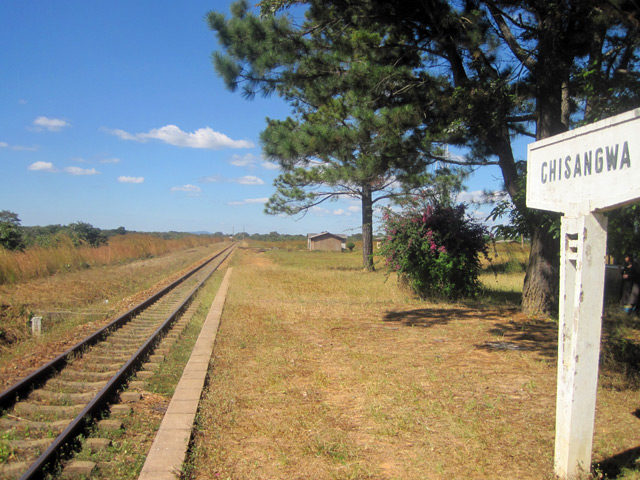
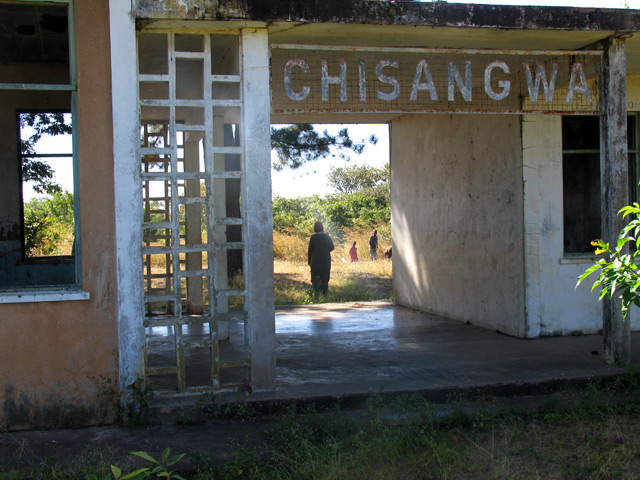
Lunch is eaten off the tailgate of the Ranger. Today it is tuna mayo, biscuits, cheese, tomatoes and fruit. These tailgate lunches are to become a welcome feature of the days on the road, a chance to stretch our legs and refuel. As we eat, some children from the nearby hamlet spot us and come over the fields, carrying their football, made from paper and string. They don't see many muzungus and as they get nearer the small ones fall back and the bigger boys drop down onto the railway line, trying to creep up and look at us unseen. Kim gradually coaxes them out by playing peek-a-boo from behind the bougainvillea bush. They speak hardly any English. A mother comes over carrying a baby on her hip. Names are exchanged. We give the children our empty drinks cans and bottles and they seem very pleased. They will be creatively recycled.
Not long after leaving the grassed-over tracks around the station and returning to the tar, we come across a Mozambique Spitting Cobra in the middle of the road. It is raised up, hooded up and ready to attack us for being in its way as it crossed the road. It can spray its venom 8 feet and if that gets in your eyes it can blind you. Luckily for us South-African-built Ford Rangers are difficult to kill.
We stop off at a town called Serenje to top up the diesel. I recognise this as where we had stopped on our first visit to Zambia almost 13 years ago. I remember I had tested the toilet round the back of the petrol station. It wasn't considered suitable for women - I can remember why! So we had also gone to the bar over the road to buy beer and use the staff toilet there. The bar is still there. At the petrol station things have moved on. Now there is a pay toilet in the corner of the dusty lot.
After another few hours, going through the dramatic landscape of valley and scrub hills of the classic Zambian miombo woodland, the vegetation changes as we gradually climb higher through passes up to the plateau. We turn off the main road and hit dirt tracks. We pass little agglomerations of huts and arrive at the campsite at Kundalila Falls at about 4.30pm. All the waterfalls we will visit are National Monuments and each has a caretaker. Kundalila means 'cooing dove' although that probably refers to the bird that lives here rather than the sound of the water, which is positively roaring. Rod says 'Let's go and look at the waterfalls before the light goes'.
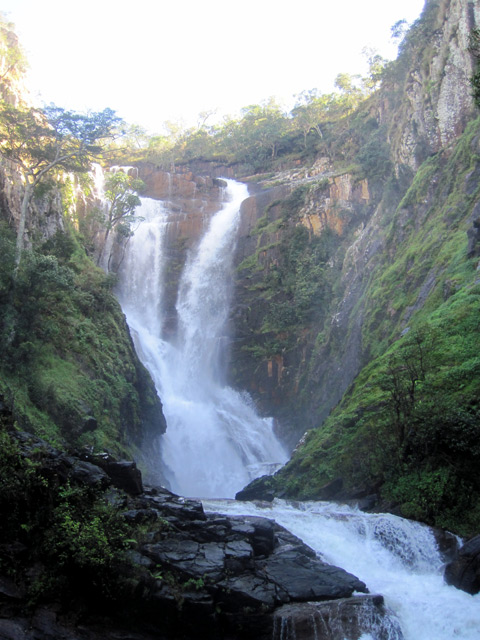
We can hear the falls and follow the trail down to a pair of rusty iron girders making a bridge over the river. I go over the makeshift bridge, get to the end, turn round and see Kim coming toward me holding a twisted vine that is draped along the side of the bridge. Horror! The vine stretches, she overbalances and falls into the river. She manages to keep hold of the vine, which stops her being swept into the swirling pool. I rush back and grab her arm. Rod grabs her other arm and we pull her through the torrential current to the bank. Scary but it could have been very serious. Kim is soaked to the skin but the dip in the icy water has shaken off the jet lag and the dust from our six-hour drive. We carry on with the walk further down and round the falls and all make it back successfully over the girders.
Unfortunately, Kim was carrying the camera when she fell in. It is inundated. I take out the battery and memory card and leave the water to drain out and evaporate.
There is no one else camping here. Just the caretaker with his big yellowing 'signing in' book and he will soon get on his bicycle and head home. As Rod and Michael are setting up the two tents, the caretaker lets Kim change her clothes in his big but pitch-dark cupboard alongside a wheelbarrow, brush, tools and some rather large spiders.
Before we left England, Rod had sent us a rare little volume entitled Guide to Little-Known Waterfalls of Zambia. Its entry for Kundalila says 'a narrow but tall (c 80m) fall, split in two at the top and disintegrating into mist at the bottom'. It adds 'camping OK, basic facilities (beware of thieving white-necked ravens)'.
The facilities are indeed basic: a brick hut with a mud floor with a hole in the ground. But the setting is amazing. The air is sweet and the stars provide their own tent high above our two little green nylon domes. Michael cooks our first dinner out here on the road. It tastes very good but we hit the beds by 7.30pm. We have been travelling for 24 hours solid.
Across the Chinese Bridge
Twelve hours later, we awake refreshed. I am sure we gained from having the stars peeping through the top of the tent as we slept. However, it was a bit chilly and we decided that the warmth gained from sharing one of the two single camp beds outweighed the squash.
Kim's boots are put in the sun on the Ranger's bonnet to help the drying out process. Breakfast of good Zambian coffee, cornflakes and muesli gives us the confidence to face the world. Along with Rod we go for a walk down the gorge to the bottom of the waterfall. It is an energetic clamber down through the trees. Getting to the bottom of the fall, it is an impressive sight. The water drops almost 240 feet in a couple of streams, crashing into a pool at the bottom, where you could swim if you wanted to. We chose not to. Returning, camp is packed up and we are on the road again.
We go back South West, down The Great North Road. Lorries come towards us from the copper belt loaded with large sheets of copper loosely folded on their flatbeds. We stop at a collection of houses with a few shops and people selling food by the roadside. We pick up some food and some more blankets. The blankets cost 40 pin (40,000 kwacha), which is about £6. A pin is the colloquial name for 10,000 kwacha. Evidently, the term was coined in the days when 10,000 kwacha was a more substantial sum of money than it is today and the notes were much smaller denominations. In those days the bundle of notes to the value of 10,000 were held together with a steel pin. We also buy some tomatoes for about 25p - but that is still over 1,000 kwacha!
We then hang a right and proceed North West through the Kasanka National Park towards the Bangweulu Wetlands. We drive along the three-kilometre Chinese-built causeway and bridge that cuts across the bottom of the Bangweulu swamp. Before the Chinese built this causeway and bridge across the swamp, you had to make a very long and winding circular journey to get from east to west in this part of Zambia. This time of year - not long after the rainy season - the Bangweulu is full of
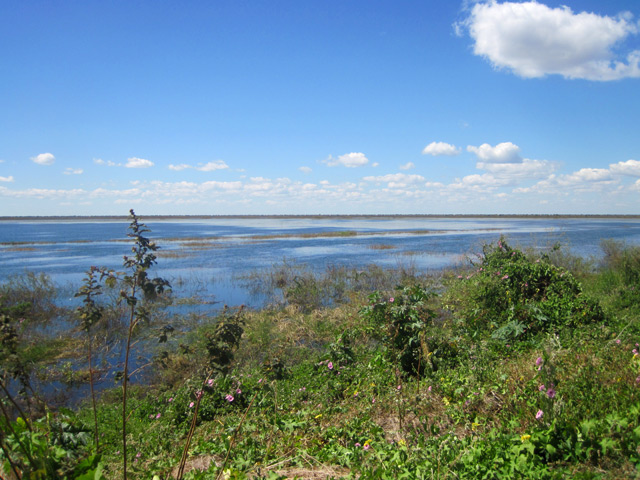
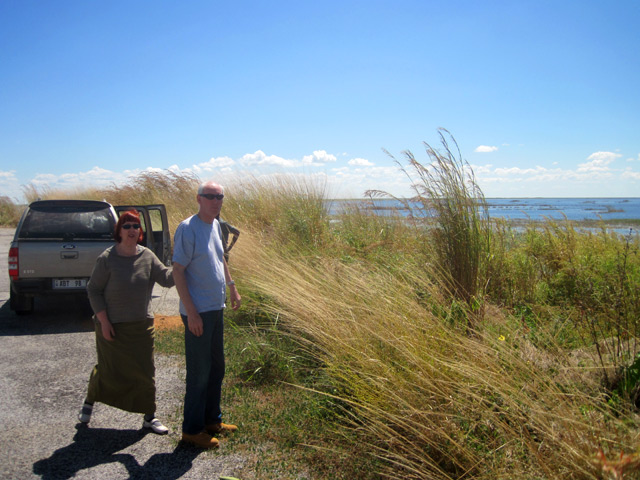
water for as far as the eye can see. It is not only an eye-opener for us, but also for Michael who has never been this way before.
In flood, the Bangweulu is a wide big massive sky merging with the blue water and reeds. We have lunch off the tailgate on a pull-in on the causeway and watch people using mokoros (dugout canoes) getting from A to B and fishing the rich waters. On the horizon, there are occasional islands of high ground standing proud. On one is a school, planted with tall non-native trees, which provide a useful signpost on the horizon.
The bridge has homemade barricades - piles old iron girders. A guard stands in a little tower just off the bridge. He lets us pass. Being muzungus, we generally pass easily through the police roadblocks with just a desultory wave.
The road has been very straight for a very long time. I wonder if we have actually gone round a corner yet. Then the curves start dramatically as we hit a town called Milembe and go north, heading for a little town on the shore of Lake Bangweulu called Samfya.
We kick up the dust as we hit it. Kim calls it a funky little place. And indeed it is - a semi-busy, bustling, scruffy micro metropolis. To escape all the excitement of this little rural town we head down to the long white beach, passing a few fishermen with their boats, and stopping off to see the post boat that runs along the lake. This is the 'resort that never was'. People had invested here to make it a Zambian holiday destination, but it had failed. Now the road to the beach is straggled with abandoned 'holiday hotels' that are now just closed bars in various states of dereliction with some empty cabins attached.
As soon as we park the Ranger on the edge of the beach some hustlers slink towards us and try half-heartedly to charge us for walking on the beach. On the little bit that we do actually walk on, we see in the surf line lots of shells of the water snail that carries the Bilharzias disease.
We do not hang around. We hit the road out of town and head west for Mansa: a crossroad town and a bit of a live wire place. Here we stop to get some diesel and ask if there are any shops open. No… it is Sunday.
But the bars are open and we pull in to one. I follow Rod as he goes to buy some water and cokes. It is typical Sunday afternoon, men at tables playing dominoes and drinking. I ask for a carton of Shake Shake, this is the Zambian maize/sorghum beer. I have never tasted it, so this will be a new experience for me. It is called Shake Shake because you have to shake it before drinking.
Soon we pull off the road into Mumbuluma falls - a Bemba word meaning growling water. The young man at the wooden barrier, Mr Steven, remembers Rod from when he was here with his family last September. As he carefully writes our details into his big book, he says there has only been one overnight camper since then (eight months ago!).
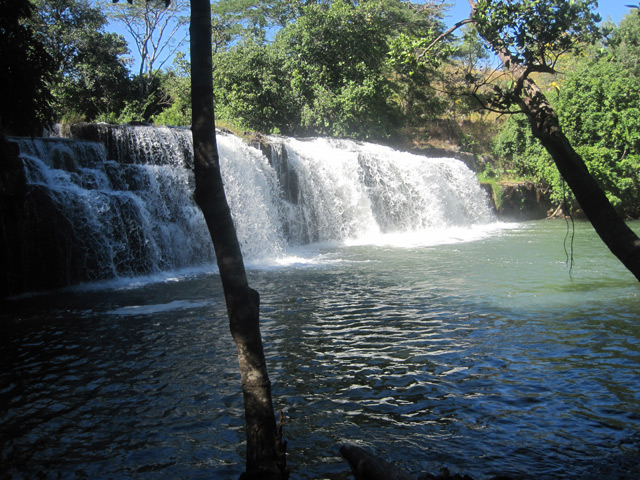
While the tents go up, Kim and I take a walk down to the waterfalls. There are two here, linked by rapids and a deep pool. We walk down the steep steps with the wooden handrail made by Mr Steven and his team and at the bottom we find two Zambian families up from Mansa enjoying the falls. The teenage boys dive headlong into the rushing water, the smaller ones play in the still pools lower down. The parents, in their Sunday best, wade into the water to have their photograph taken with the falls behind them. They pose confidently, the father in his shirt and tie with his trousers rolled up, his young wife elegant in her long traditional dress. As they walk back across the rocks to the riverbank, the woman slips and sits down in the water. She gets up smiling. We talk to her and she says it is very nice in the water. So it's not just Kim who accidently goes swimming. We explore for a bit along the riverbanks. Then the family leave to go home and here we are, left on our own out in the bush.
Back at camp, Michael has set up his mobile kitchen and dinner is on the go. I try my Shake Shake. It's a commercialised version of the home-brewed 'seven day beer' that we have come across in many African countries. It is a bit sour and thick like thin yoghurt porridge soup. Though 6% alcohol, I do not think there's much opportunity for a market segment for Shake Shake in England, not even as a cult drink.
Waking up in the morning, opening the tent and looking out, the only thing we can say is, what a way to start the day. Proper savannah bush, with the sound of waterfalls as a constant background. The temperature is warmer here. With our extra blankets we are positively cosy at night. Rod and Michael have found a way of locking our two single camp beds together to form a double. And, best of all, every night of this trip Michael boils some water from the river and puts in two hot-water bottles.
Breakfast is coffee, cereal and watermelon. Kim and I wander down to the waterfall again and meet Mr Steven the caretaker. He is supervising the cleaning and brushing of the paths by some young boys from the local village over the river. Mr Steven pays some of the boys' school fees for this work and we can see they do well under his supervision. The campsite and falls are very clean and he has done a great job putting in little pathways and handrails. He is by far the best National Monument caretaker we meet on this journey. He has used his own initiative to put a path into the lower falls opening up the big curtain of water. He is patiently waiting for concrete for more paths to be sent by Head Office. Zambians are famous for their patience. We fear Mr Steven will have to wait some time.
When we get back to our camp, the Ranger is loaded up. We tip Mr Steven. He really deserves it. It turns out that he is the only caretaker on this trip that Rod thinks is worthy of a tip. We do notice and appreciate the attitude and initiative of the caretakers but some of them sit at their site all day and don't even think to pick up rubbish or slash the bush to make an area for tents. We also leave Mr Steven my three-quarter full carton of Shake Shake. He takes it appreciatively saying he will drink it ‘after 18 hundred’. Meaning after 6pm when he knocks off work.
Touching the Congo
We set off on another five and a half hour drive - this time on tar. Rod tells us we still don’t have a Prime Minister. We have been following the Luapula River that marks the boundary between Zambia and the Democratic Republic of Congo. We drive into Mwense, a wild looking place that is a real hustle and a bustle with shops that look like they are open.
On the main strip we come across a large throng of people. A band of drummers in trilby hats with red feathers are playing. Latex gloves are being handed out and people are going around picking up litter. This is obviously a big event. We go over the river by a bridge and hydro electricity system and continue north. There is a sign just outside of Mwense that says Kick Out Cholera Before It Kicks You Out. Obviously in the rainy season the long drops flood and cholera is a serious problem.
The Luapula is a mighty river that has wide cascades and rapids and then runs like a blue snake to Lake Mweru. The lake is rich in culture and trade and shared almost equally between Zambia and Congo. From Lake Mweru the Congo River starts.
We stop to buy some sweet potatoes from a pile on a bucket in front of a collection of huts a hundred yards back off the road. A young girl aged about 8 comes out to serve us. Halfway through the purchase Rod spots a big bus coming over the ridge and heading for us at a pace. He quickly jumps in the car and pulls off the road. The bus passes like the wind.
We head on up to Mbereshi, another junction town. This one built around a mission station. We stop to look at an early Methodist Missionary church, built by The London Missionary Society in 1900 in that classic Methodist Victorian redbrick style, but now looking somewhat neglected and forlorn. There is a small graveyard nearby. We look at the graves of two of the early male missionaries but later learn about the instrumental role of Mabel Shaw (born in Bilston in 1889) who was the first single female missionary to be sent to Central Africa and who founded the girls’ boarding school here.
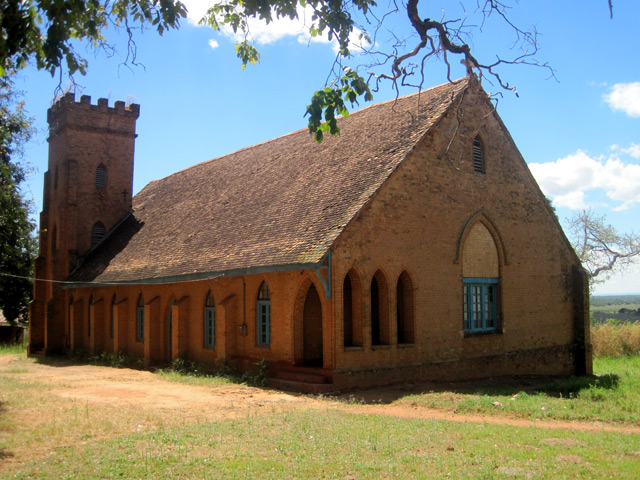
It is nice and shady by the church, so we have lunch here off the tailgate of the Ranger. Several of the local people come by. All of them stop to talk and welcome us to their village. One man, slightly worse for wear because of the Shake Shake, tells us that he is Samuel Matete's cousin. Matete was a world-famous hurdler in the 1990s. We decide this might be true.
We then head east for our next waterfall, Ntumba Chushi. We pull off the tarmac and trundle along a dirt road and into the bush to be greeted by the caretaker, Mr James. Rod mentions that he had been here in September and asks what has happened to the caretaker who was here then. Mr James says he has been transferred to another National Monument waterfall. From the visitors’ book it looks like there has been an average of one visitor a month here.
We drive right up to a platform of flat soil within stone walls in front of this thundering waterfall and park the Ranger. This is where we are going to camp. It’s a compact but powerful fall crashing into a tree lined pool, believed to be a sanctuary of spirits. The waters of the nearby Ng’ona River are used for bathing local chiefs before they are installed on the throne so as to cleanse them of bad luck and misfortune.
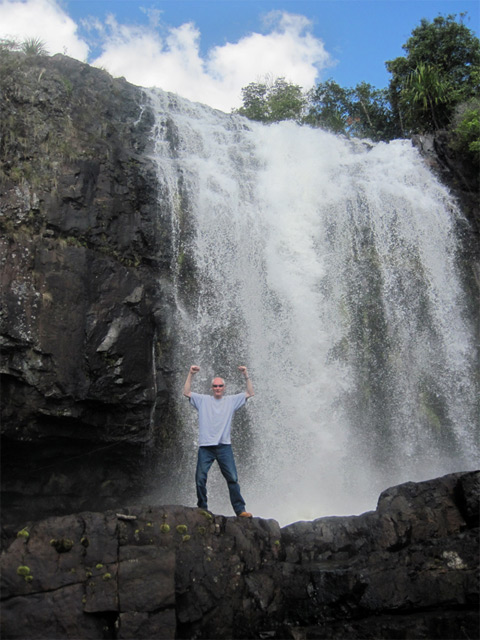
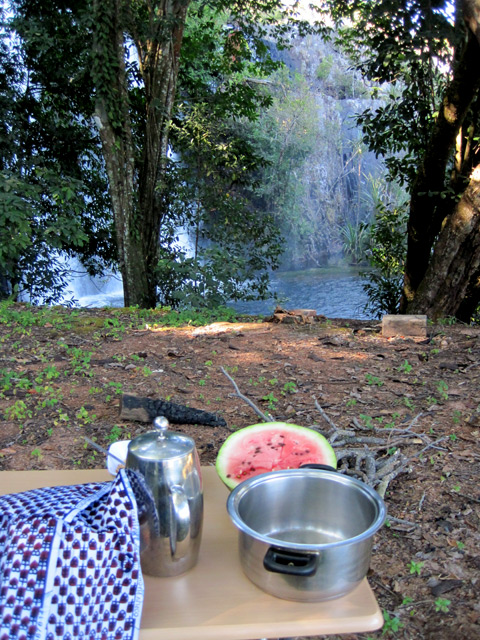
We look in awe but then realise that just a couple of hundred yards further on there is another spectacular fall. To get to it we have to cross a stone structure that has been painted with a sign that says, "Take care of kids on the bridge". But it is not only children who have to take care. Floods have washed out the approach ramps at both ends of the bridge, so you have to climb a jumble of rocks to get up and then over and down the other side. But it is worth it as we emerge into a green bowl by the side of the other fall, which spills over the edge of the cliff for fifty yards or so. The spray from the wide bridal veil fall soaks us. The rainbows shimmer. A mega wow.
Rod suggests we have a look at the series of falls above these. So we clamber up a cliff face path into a wood. We come out into a set of gentle falls, flowing into flat pools of lava-like rock. They are not as spectacular but they are very pleasing and have been described as among the most beautiful in central Africa, with their views over the Luapula River. The whole area has a peaceful, Eden-like quality. We move on up through the shady woods, crossing through a deserted picnic area, via a series of rapids and then on to yet another fall, this time more dramatic with cascades and pools and cascade after falls. It is a beautiful place.
Michael is also very impressed. It is another new sight and experience for him as well, so we are all sharing this together. Rod goes swimming in one of the pools. He and Michael then leave to set up camp. On the way back they are going to pick up the bits of litter we had passed. How can anyone come here and desecrate such a beautiful environment? Kim and I stay up at the top falls for a while, luxuriating in the landscape and the clear fresh air; still not quite believing how far we have travelled in the three days since we left London.
As we clamber back down the rock face, I see that the tents are already up and Michael is carrying branches with Mr James. Tonight we will have our drinks round the campfire. Mosi beers followed by a glass or two of South African wine with dinner at the picnic table. Only trouble is, it's damn noisy here in front of the big fall. The wall of noise makes it necessary to shout to each other.
Michael does wonders with dinner on a gas bottle and one burner. We ask how he came to be cook and learn that he had started out as nanny (or ‘manny’) to Rod and Guz’s two young boys at Kutandala, the remote and beautiful camp they set up out in North Luangwa. Michael had started as a ‘casual’ helping build the camp at the start of the season. But Rod had spotted something in him. Not many men would want to look after children (a woman’s job) but Michael had a friend who had done it. And so Rod asked their cook, Franco if he thought Michael would be a good person to look after Louis and Daniel. Franco looked at him and said: ‘Obvious’ (meaning ‘of course’) and when asked to explain he added ‘He’s got jacked-up eyes’ (meaning, ‘he looks smart and intelligent’). It worked out really well and Michael was great with the boys. But he was also really interested in the cooking and would spend hours with Guz asking her about her recipes and how to make the food for the guests. When the long-standing cook, Franco, left to go and work closer to home, at another camp (John Coppinger's Tafika), Michael, with Guz's expert tutoring, successfully stepped into his apron.
Darkness falls at about 6.30pm. After dinner Michael walks down to the river by the light of his head torch to get water for the washing up. He and Rod use the river for washing too. Rod explains this is quite brave of Michael. He doesn’t know the areas we are travelling through. He doesn’t know if the rivers contain snakes and crocodiles. But he trusts Mr Rod when he tells him it is OK.
It is warmer here at Ntumba Chusi. As we fall asleep we see, through the top of our own tent, another tent of stars. The roar of the falls does not keep us awake, although it is weird to wake up in the night and hear the rushing water – a bit like a soothing, natural white noise.
And, no, it is not turned off in the night. We wake to the pounding sound of the water spirits. Over breakfast, Rod asks us if we want any news from the UK. He listens to the World Service in his tent at night. We say, one bit of information only please. ‘Gordon Brown has resigned and the Lib Dems are in talks with Labour.’ Hmm interesting, but what about that warm shower you mentioned?
The shower is a masterpiece of improvisation: a bucket of water from the river is put on the gas burner. When it is warm, it is put next to a canvas shower stall erected by the side of the Ranger. A boat bilge pump is put in the bucket of warm water. A length of hose with a showerhead attached to the pump is draped over the top of the shower stall. One person gets into the shower; another person connects the pump to the car’s battery by a couple of wires and crocodile clips. Get wet. Stop shower. Soap up. Start shower. Rinse. It works very well. One bucket of water, carefully used, goes a long way!
As we are leaving Mr James, the caretaker, blags a box of matches then tries to hit Rod up for a ‘contribution’. Rod is having none of it. This site is nothing like as well run as Mumbuluma. There are a number of decaying buildings that could have been easily restored. The bridge to the second fall is very difficult to climb on to because of the flood destruction and could have been fixed with a bit of work. Then there is some litter dumped and not cleared up. The quality of each site is entirely down to the caretakers. If only they all had the gumption and go ahead of Mr Steven at Mumbuluma then these newly designated National Heritage Monuments could attract more visitors.
One of the things that surprises us at first is how few Zambians we see in the national parks and at the waterfalls. But we are looking at it from a Western perspective. Rod reminds us that the concept of travel for ‘a holiday’ is not an African one. Relatively few black Zambians have the money to take holidays. Many of them work away from home and if they travel, it is to see their families not to look at waterfalls, monuments, or animals. When we ask Michael if he would bring his wife to look at a national heritage site, like the ones we are seeing on this trip, he simply says: ‘Why would I do that? She is much too busy.’
Zambia’s national motto is ‘One Zambia, One Nation’, a reference to their many peaceful and united tribes. Every school has its own motto proudly displayed on its sign - usually hand painted on a six-foot concrete slab on a base. Even taxi drivers have their own mottos, ‘Always room for one more’ Kim’s favourite school motto is ‘Many sticks make a bundle’. While, for me, the standout is still ‘Knowledge is the New Beauty’. Seeing the school children walking miles every day to get to their schools, dressed in their neat uniforms, I know they believe it.
We stop in a small village to get some takeaways from the local bar. We spot a motto painted on the front of a house that says, ‘Excessive loquasity is incompatible with mental fequndity’, meaning if you talk too much your mind does not grow. In the bar they are slacking and watching DVDs of modern Congolese music. In our Ford Ranger Kim and Rod argue through the merits of the motto for several miles. Michael and I sit quietly in the back. Nuff said.
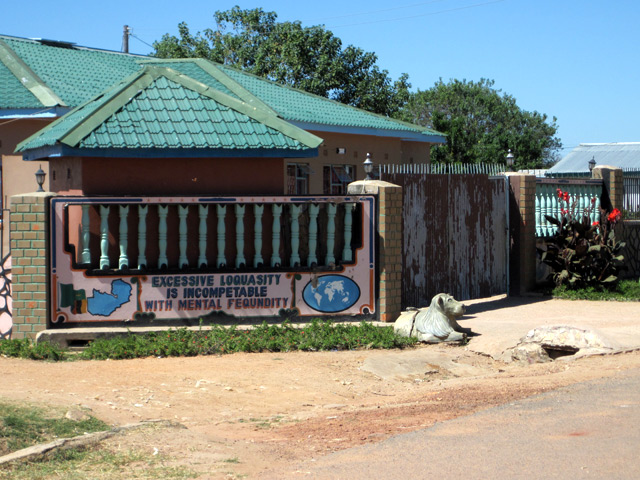
At Kawanbwa, a T-junction town, we stop to fill up at a petrol station called ‘Fresh Spirit’. Rod tells a story about a time he was at a petrol station and a Lusaka mini bus driver was getting 10 litres of fuel. Seeing Rod getting a full tank he said: ‘Bwana, why you putting all your pocket into the tank? What if you break down and have to push the car with the weight of that full tank? Also, what if your mother falls sick and needs you to help her out?’ Another insight into the way Zambian minds work.
A big mobile phone tower is being built next to the petrol station. Guys are hanging off the top tightening bolts and fixing the antennae. There are already two other towers standing there but, as Michael tells us, the Zambian phone companies do not like sharing masts. Zain seems to be the biggest mobile phone operator in Zambia. That’s the one Michael belongs to and he seems to get a signal in most built up areas. Rod’s provider is much slower. Zain is Purple. They supply their purple paint to everyone willing to advertise them. Many of the shops we stop at are purple.
With a full tank we move onto the market in this lovely town. I buy a shirt. There are no buttons on the cuffs. The man at the next stall tries to sell me cufflinks for it. I tell him I will roll the sleeves. He laughs. This market has everything, food, clothes, fresh meat and fish. We wander around, looking in on the covered market, which is full of dried fish and one stall selling bread rolls. Then we walk out into the sun and the women selling vegetables start giggling and laughing at Kim. She asks them what they are so amused by. They point to her hair, which is brightly hennaed. We rejoin Rod and Michael and have a Sprite in a wooden shack-shop that has a framed graduation photograph of the owner in her mortarboard and gown. Michael says that a number of people have come up to him asking if he knows the ‘white woman with make-up in her hair’. He says it is the first time they have seen such a thing. He is enjoying the temporary celebrity more than Kim.
There is anything and everything for sale in the shops and stalls. I linger longingly by the tool shops. In the clothes shops Barack Obama is a popular image on shirts and mirrored belts.
Sadly we don’t have time to visit the ‘Wasted Days’ bar before we leave.
The Great Snake Spirit
We head out of town, hitting the dirt road now. We are on the edge of a swamp, thick vast dense mats of papyrus grow in the shallow water. Sugar cane fields thrive in the dark wetland soil.
We pass over a new metal bridge. Last time Rob passed by here it was a pontoon. That pontoon is now beached and neglected on the riverbank. We see a picturesque pool full of water lilies. This is the Kalungwishi River, which is to give us so much pleasure.
We hang a left onto a sparse track and drive along, passing a couple of people carrying fish. There are clusters of thatched huts barely visible way back in the bush. We bump along for a while then in the distance, framed by the trees, we see a white streak and drifting spray.
This is the magnificent Lumangwe, without a doubt a totally stunning fall and the largest one to be totally within Zambia (Victoria Falls crosses the border). As we get closer we see the white is a gigantic torrent pouring over a massive drop – almost 40 metres deep and 140 metres wide. The spray is dense and at this time of year – the end of the rainy season – it rises almost 100 metres into the air. The waterfall is said to be the home of the Great Snake Spirit called Lumangwe, a snake that is said to have stretched itself between the Lumangwe and Kabweluma Falls, some 5 kilometres away.
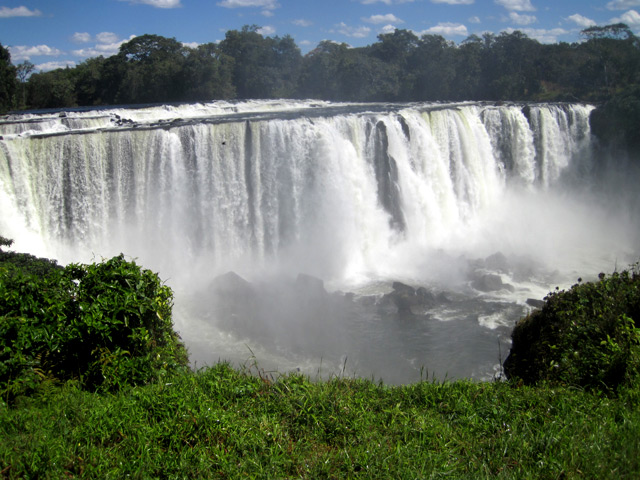
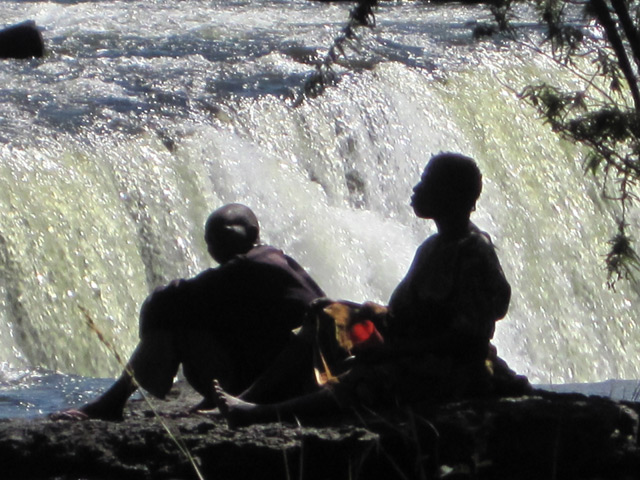
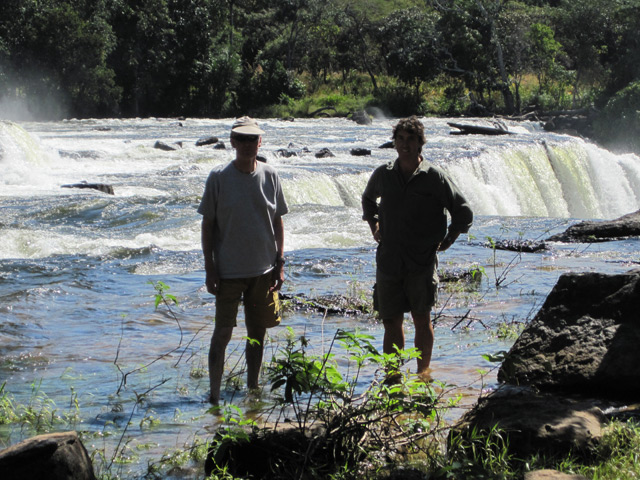
The Guide to Little-Known Waterfalls of Zambia calls these ‘the most stunning beautiful of Zambia's little known waterfalls’. I agree with the authors entirely. The wide double crescent edge and deep drop has little cliffs and falls above it which disturb the water, before it drops over the sharp edge. The undisturbed water makes green streaks among the foam.
What is unbelievable is that we can just drive up over the grass and park right by the thundering cascade – twenty-five yards away from the edge. Unusually we are not completely alone. A few men and women are breaking stones by hand then putting them into piles ready to do track maintenance. They seem mildly surprised to see us but wave a friendly hand and return to their work. We walk to the natural vantage point where you can see the whole width and depth of the falls and get drenched by the refreshing spray. Then we paddle in the shallow water at the top of he falls where there are reeds and a little sandy bay and keep tiptoeing to the edge to marvel at this incredible fall. Below in the gorge the water flows out though massive rocks at what seems an incredible speed. Kim says it reminds her of the film of The Last of the Mohicans. I am not prepared to make the Daniel Day-Lewis leap into the foaming water, although it is worryingly hypnotic.
Michael is particularly happy here. Not only is he seeing an amazing piece of national heritage but also there is a very basic thatched shelter that he can use to set up his kitchen. He excels himself at lunch with a beautiful potato omelette.
As we are sitting relaxing, an elderly man and woman who have been breaking stones come down for their break. They walk out through the shallow water at the top of the falls and sit on a flat rock right near the edge. All they have is some water and what looks like a few balls of mealie meal (maize flour). They look out over the water. It’s a view that they see every day and yet you sense that they never fail to recognise its power. After about 20 minutes they return to work for another few hours before beginning the long walk home to their village.
As the sun sets, the light and the water changes from fluid platinum to pewter, the spray has a life of its own, billowing up in dense clouds, as the waves of water crashes down onto the rocks creating plumes of spray that are pushed upwards by pressure from below.
We have dinner round a fire at the water’s edge. We could be the last people on earth.
The roar of the water has become a soothing accompaniment to our lengthy night sleeps. We wake up fresh and ready for breakfast on the edge of the precipice. Pineapple, bought in the market in Kawanbwa, never tasted better. We hear we have a new Prime Minister, David Cameron and a Conservative/Lib Dem coalition government.
Rod suggests I take the path down the cliff to look at the fall from water level. It is a bit of a scramble but worth it. The continuous curtain of water is a very impressive sight.
With great sadness we pack up and leave the very special Lumangwe Falls. To be able to stand at the edge and look down into the churning water below is a great privilege. The Great Snake Spirit is very bountiful.
We drive a little further down the dirt road and turn off towards the Kabweluma Falls, just a bit further along the Kalungwishi River. As always there is a faded sign, hand painted, to direct you down a barely used somewhat overgrown track. We roll through dense grass and park in a clearing by another sign pointing into the bush saying Kabweluma Falls - 300 metres. Well, that must have been Zambian metres because it feels a lot more to us as we force our way through bush and grass, clambering over old stone pathways. We traverse a stream by dropping some large stones into it. Then enter the last remnants of the tropical forest that once covered Zambia. The closer you get to the falls the more the dampness increases. Everything is all a slip and slither down solid emerald green slopes. Then we burst out into the open space and the sun, like explorers in some Rider Haggard tale.
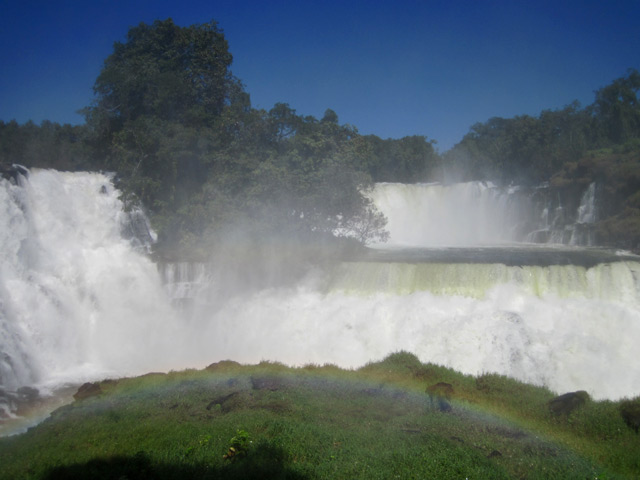
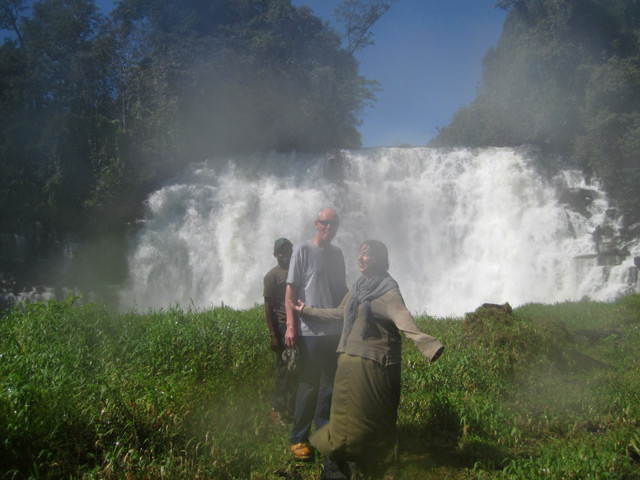
As the Kabweluma Falls heave into view you realise why they are rated so highly. This superb fall has everything. It has side cascades, ladders, curtains even a perfect crescent cascade into a large pool leading to another curtain. The quality and shape of the falls are totally unique, the spectacle compact and in scale. If you were attempting to design the perfect waterfall this would be it. The refreshing coolness from the spray envelopes you and rainbows punctuate it from every angle. Apparently the spirits do not allow the building of houses or any frivolity here. We hope that our dancing around in the spray is acceptable! Kabweluma is a very special and magical fall. Its remoteness, variety, the approach through the high grass and the old jungle make it number one. The incredible volume of spray being created by this very complex series of falls is channelled into the centre of the pool. We are sodden through after a few minutes of standing on a promontory in front of the falls. Hmm that T-shirt needed washing.
Back at the car we stand in the sun and steam ourselves dry. We had wondered before coming whether we might find we were seeing a few too many waterfalls. We are surprised at just how different each one is, in landscape, scale and spirit. We leave Kabweluma on a high, amazed at the difference between the two stunning falls within a few miles of each other.
The dirt roads continue. Occasionally we pass through a collection of huts or a small village where kamikaze chickens and goats playing chicken deliberately try to confuse drivers by zigzagging in front of them. As cars are not a very common sight they cause quite an excitement. Children wave and run alongside us, shouting ‘muzungus!’
After about an hour we come up to a roadblock – a wooden branch-barrier across the road. The local council put this up. A bloke in a shirt with a picture of the Portuguese footballer Ronaldo comes out from a thatched shelter on one side of the road. From some huts on the other side a youngster in a similar shirt rushes out. Rod has a way of ensuring we don’t get unnecessarily delayed by the officials we meet at the many roadblocks we pass through. The trick, he says, is to ask them a question before they can ask you one. It always works. So here he asks for directions to Kundabwika Falls, the last of the major falls on the Kalungwishi River before it flows into Lake Mweru. The official takes great care in explaining the turn off to us and he assures us that Mr Chanda, the caretaker, will be there. We learn that Mr Chanda has been at the site two weeks and has ‘done slashie’ to cut a better track. They raise the wooden barrier and wave us on our way.
A few miles on, as we think we are nearing the turnoff, Rod gets out his GPS and started reading down the distance – 1,000 yards, 500 yards - by the time we get down to 8 yards, we can see a gap in the grass with a pair of wheel tracks in it running into the bush.
This waterfall has only recently been made a National Monument and Mr Chanda is still building his office, so far just a circle of sticks in the ground. We park right by the edge of the river. This is unmolested bush. There is nothing here that should not be, including long drop toilets. We push through the vegetation to find the beautiful sight of a bend in the river with rocks and rapids. There is a shady space by the river below some trees and a collection of large rocks sticking out into the river to sit on. Some have smooth faces that make them look like polished marble. How many rivers in flood had it taken to smooth them out like that?
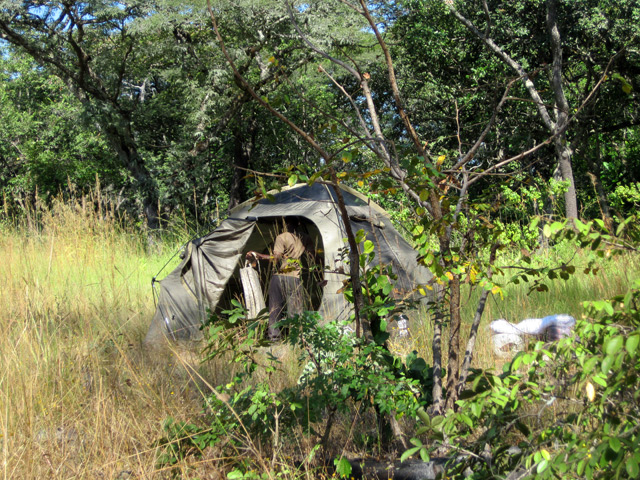
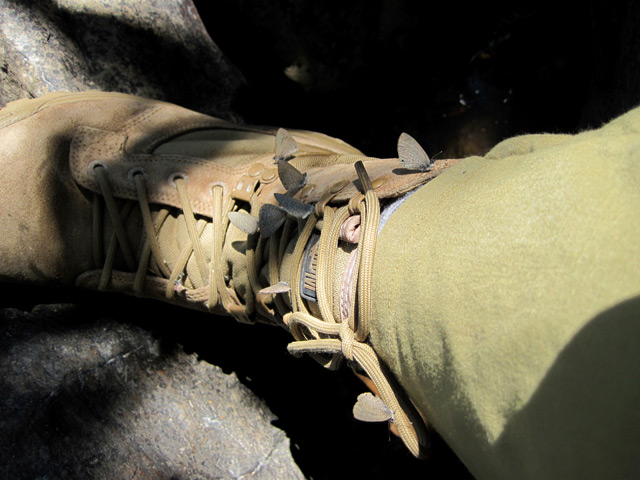
Camp is set up. We’ve learned it is best to hang out separately while Rod and Michael are doing this. First night I had helped a bit but we realised that they preferred to do it themselves.. They probably appreciated the space as well. Sitting for hours in car all day, then dinner together. Everybody needs a bit of private space.
So Kim and I go down to the river and I donate my Oakley sunglasses to thank the river gods. They are on top of my hat and I am standing on a boulder in the river. As Kim takes my photograph, I pull off my cap forgetting the sunglasses are there and plop, they are in the fast flowing river. Probably half way to the Congo by now.
I nip back up to camp to get a drink when in a flurry Mr Chanda arrives on the back of a bicycle ridden by a young boy. Rod does the business, handing over the kwacha and signing into the big book. Evidently we are the first visitors. Rod says Mr Chanda and the boy cyclist will show us the waterfall. ‘He says it is five minutes away.’ It is a five-minute walk back to the unfinished office; a good 15-minute walk up a track; a 20-minute hack across country; then a scramble along a cliff face jumping from boulder to boulder. But it is worth it. Downstream is a pretty curtain of water and very nice rapids afterwards. On the way back Rod and I have a running joke about how we could mess up this pristine environment right good and proper: put in a tar road, a bar, supermarket, a fast food caravan selling bacon sarnies, then a Burger King and a hotel. Then sell the lease to a company to dump toxic chemicals.
Back at camp, we admire the boy's bike. It has rough welding repairs on the rear stays. An electronic gizmo on the handlebar plays Jingle Bells, with a knob to change the pitch. A rear carrier/seat is made of reinforcing bar. Some heavy-duty brackets are clamped on the front wheel axle. It is a classic piece of bush transport. You see these Chinese bikes everywhere, carrying large sacks and huge loads, two or more people, or a few goats. They are the main form of transport for most people out in the bush. You see them on the dirt road miles from nowhere carrying anything and everything.
Dinner that night is round the campfire - steak and steamed treacle pudding. While the pudding steams on the gas burner Michael collects some stones to make a hearth, lights up some charcoal and cooks the steaks. We see a lot of charcoal sold by the roadside, generally in large grey plastic sacks with a cap of woven reeds on top.
In the morning, our breakfast table is set up by the rocks on the side of the river. We eat standing up, as the chairs are still wet with dew.
Part 1 - Part 2